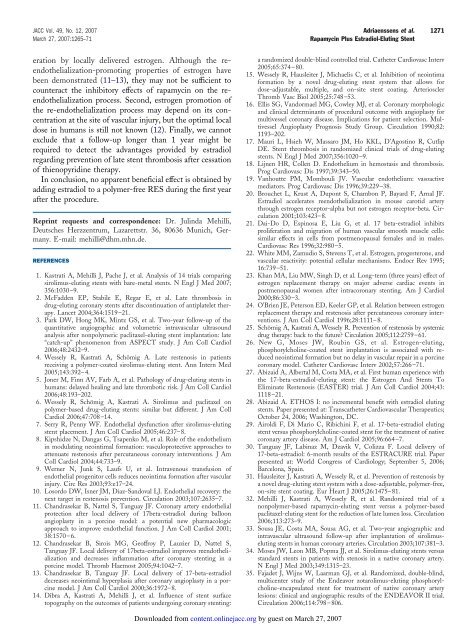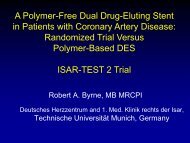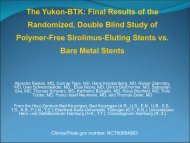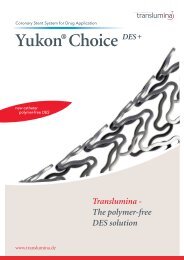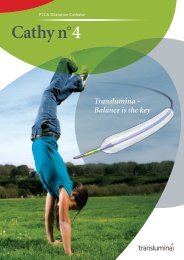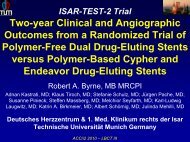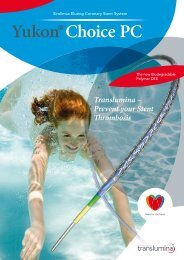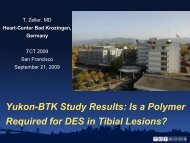PDF download - Translumina
PDF download - Translumina
PDF download - Translumina
You also want an ePaper? Increase the reach of your titles
YUMPU automatically turns print PDFs into web optimized ePapers that Google loves.
JACC Vol. 49, No. 12, 2007 Adriaenssens et al.<br />
March 27, 2007:1265–71 Rapamycin Plus Estradiol-Eluting Stent<br />
eration by locally delivered estrogen. Although the reendothelialization-promoting<br />
properties of estrogen have<br />
been demonstrated (11–13), they may not be sufficient to<br />
counteract the inhibitory effects of rapamycin on the reendothelialization<br />
process. Second, estrogen promotion of<br />
the re-endothelialization process may depend on its concentration<br />
at the site of vascular injury, but the optimal local<br />
dose in humans is still not known (12). Finally, we cannot<br />
exclude that a follow-up longer than 1 year might be<br />
required to detect the advantages provided by estradiol<br />
regarding prevention of late stent thrombosis after cessation<br />
of thienopyridine therapy.<br />
In conclusion, no apparent beneficial effect is obtained by<br />
adding estradiol to a polymer-free RES during the first year<br />
after the procedure.<br />
Reprint requests and correspondence: Dr. Julinda Mehilli,<br />
Deutsches Herzzentrum, Lazarettstr. 36, 80636 Munich, Germany.<br />
E-mail: mehilli@dhm.mhn.de.<br />
REFERENCES<br />
1. Kastrati A, Mehilli J, Pache J, et al. Analysis of 14 trials comparing<br />
sirolimus-eluting stents with bare-metal stents. N Engl J Med 2007;<br />
356:1030–9.<br />
2. McFadden EP, Stabile E, Regar E, et al. Late thrombosis in<br />
drug-eluting coronary stents after discontinuation of antiplatelet therapy.<br />
Lancet 2004;364:1519–21.<br />
3. Park DW, Hong MK, Mintz GS, et al. Two-year follow-up of the<br />
quantitative angiographic and volumetric intravascular ultrasound<br />
analysis after nonpolymeric paclitaxel-eluting stent implantation: late<br />
“catch-up” phenomenon from ASPECT study. J Am Coll Cardiol<br />
2006;48:2432–9.<br />
4. Wessely R, Kastrati A, Schömig A. Late restenosis in patients<br />
receiving a polymer-coated sirolimus-eluting stent. Ann Intern Med<br />
2005;143:392–4.<br />
5. Joner M, Finn AV, Farb A, et al. Pathology of drug-eluting stents in<br />
humans: delayed healing and late thrombotic risk. J Am Coll Cardiol<br />
2006;48:193–202.<br />
6. Wessely R, Schömig A, Kastrati A. Sirolimus and paclitaxel on<br />
polymer-based drug-eluting stents: similar but different. J Am Coll<br />
Cardiol 2006;47:708–14.<br />
7. Serry R, Penny WF. Endothelial dysfunction after sirolimus-eluting<br />
stent placement. J Am Coll Cardiol 2005;46:237–8.<br />
8. Kipshidze N, Dangas G, Tsapenko M, et al. Role of the endothelium<br />
in modulating neointimal formation: vasculoprotective approaches to<br />
attenuate restenosis after percutaneous coronary interventions. J Am<br />
Coll Cardiol 2004;44:733–9.<br />
9. Werner N, Junk S, Laufs U, et al. Intravenous transfusion of<br />
endothelial progenitor cells reduces neointima formation after vascular<br />
injury. Circ Res 2003;93:e17–24.<br />
10. Losordo DW, Isner JM, Diaz-Sandoval LJ. Endothelial recovery: the<br />
next target in restenosis prevention. Circulation 2003;107:2635–7.<br />
11. Chandrasekar B, Nattel S, Tanguay JF. Coronary artery endothelial<br />
protection after local delivery of 17beta-estradiol during balloon<br />
angioplasty in a porcine model: a potential new pharmacologic<br />
approach to improve endothelial function. J Am Coll Cardiol 2001;<br />
38:1570–6.<br />
12. Chandrasekar B, Sirois MG, Geoffroy P, Lauzier D, Nattel S,<br />
Tanguay JF. Local delivery of 17beta-estradiol improves reendothelialization<br />
and decreases inflammation after coronary stenting in a<br />
porcine model. Thromb Haemost 2005;94:1042–7.<br />
13. Chandrasekar B, Tanguay JF. Local delivery of 17-beta-estradiol<br />
decreases neointimal hyperplasia after coronary angioplasty in a porcine<br />
model. J Am Coll Cardiol 2000;36:1972–8.<br />
14. Dibra A, Kastrati A, Mehilli J, et al. Influence of stent surface<br />
topography on the outcomes of patients undergoing coronary stenting:<br />
Downloaded from<br />
content.onlinejacc.org by guest on March 27, 2007<br />
1271<br />
a randomized double-blind controlled trial. Catheter Cardiovasc Interv<br />
2005;65:374–80.<br />
15. Wessely R, Hausleiter J, Michaelis C, et al. Inhibition of neointima<br />
formation by a novel drug-eluting stent system that allows for<br />
dose-adjustable, multiple, and on-site stent coating. Arterioscler<br />
Thromb Vasc Biol 2005;25:748–53.<br />
16. Ellis SG, Vandormael MG, Cowley MJ, et al. Coronary morphologic<br />
and clinical determinants of procedural outcome with angioplasty for<br />
multivessel coronary disease. Implications for patient selection. Multivessel<br />
Angioplasty Prognosis Study Group. Circulation 1990;82:<br />
1193–202.<br />
17. Mauri L, Hsieh W, Massaro JM, Ho KKL, D’Agostino R, Cutlip<br />
DE. Stent thrombosis in randomized clinical trials of drug-eluting<br />
stents. N Engl J Med 2007;356:1020–9.<br />
18. Lijnen HR, Collen D. Endothelium in hemostasis and thrombosis.<br />
Prog Cardiovasc Dis 1997;39:343–50.<br />
19. Vanhoutte PM, Mombouli JV. Vascular endothelium: vasoactive<br />
mediators. Prog Cardiovasc Dis 1996;39:229–38.<br />
20. Brouchet L, Krust A, Dupont S, Chambon P, Bayard F, Arnal JF.<br />
Estradiol accelerates reendothelialization in mouse carotid artery<br />
through estrogen receptor-alpha but not estrogen receptor-beta. Circulation<br />
2001;103:423–8.<br />
21. Dai-Do D, Espinosa E, Liu G, et al. 17 beta-estradiol inhibits<br />
proliferation and migration of human vascular smooth muscle cells:<br />
similar effects in cells from postmenopausal females and in males.<br />
Cardiovasc Res 1996;32:980–5.<br />
22. White MM, Zamudio S, Stevens T, et al. Estrogen, progesterone, and<br />
vascular reactivity: potential cellular mechanisms. Endocr Rev 1995;<br />
16:739–51.<br />
23. Khan MA, Liu MW, Singh D, et al. Long-term (three years) effect of<br />
estrogen replacement therapy on major adverse cardiac events in<br />
postmenopausal women after intracoronary stenting. Am J Cardiol<br />
2000;86:330–3.<br />
24. O’Brien JE, Peterson ED, Keeler GP, et al. Relation between estrogen<br />
replacement therapy and restenosis after percutaneous coronary interventions.<br />
J Am Coll Cardiol 1996;28:1111–8.<br />
25. Schömig A, Kastrati A, Wessely R. Prevention of restenosis by systemic<br />
drug therapy: back to the future? Circulation 2005;112:2759–61.<br />
26. New G, Moses JW, Roubin GS, et al. Estrogen-eluting,<br />
phosphorylcholine-coated stent implantation is associated with reduced<br />
neointimal formation but no delay in vascular repair in a porcine<br />
coronary model. Catheter Cardiovasc Interv 2002;57:266–71.<br />
27. Abizaid A, Albertal M, Costa MA, et al. First human experience with<br />
the 17-beta-estradiol-eluting stent: the Estrogen And Stents To<br />
Eliminate Restenosis (EASTER) trial. J Am Coll Cardiol 2004;43:<br />
1118–21.<br />
28. Abizaid A. ETHOS I: no incremental benefit with estradiol eluting<br />
stents. Paper presented at: Transcatheter Cardiovascular Therapeutics;<br />
October 24, 2006; Washington, DC.<br />
29. Airoldi F, Di Mario C, Ribichini F, et al. 17-beta-estradiol eluting<br />
stent versus phosphorylcholine-coated stent for the treatment of native<br />
coronary artery disease. Am J Cardiol 2005;96:664–7.<br />
30. Tanguay JF, Labinaz M, Dzavik V, Colizza F. Local delivery of<br />
17-beta-estradiol: 6-month results of the ESTRACURE trial. Paper<br />
presented at: World Congress of Cardiology; September 5, 2006;<br />
Barcelona, Spain.<br />
31. Hausleiter J, Kastrati A, Wessely R, et al. Prevention of restenosis by<br />
a novel drug-eluting stent system with a dose-adjustable, polymer-free,<br />
on-site stent coating. Eur Heart J 2005;26:1475–81.<br />
32. Mehilli J, Kastrati A, Wessely R, et al. Randomized trial of a<br />
nonpolymer-based rapamycin-eluting stent versus a polymer-based<br />
paclitaxel-eluting stent for the reduction of late lumen loss. Circulation<br />
2006;113:273–9.<br />
33. Sousa JE, Costa MA, Sousa AG, et al. Two-year angiographic and<br />
intravascular ultrasound follow-up after implantation of sirolimuseluting<br />
stents in human coronary arteries. Circulation 2003;107:381–3.<br />
34. Moses JW, Leon MB, Popma JJ, et al. Sirolimus-eluting stents versus<br />
standard stents in patients with stenosis in a native coronary artery.<br />
N Engl J Med 2003;349:1315–23.<br />
35. Fajadet J, Wijns W, Laarman GJ, et al. Randomized, double-blind,<br />
multicenter study of the Endeavor zotarolimus-eluting phosphorylcholine-encapsulated<br />
stent for treatment of native coronary artery<br />
lesions: clinical and angiographic results of the ENDEAVOR II trial.<br />
Circulation 2006;114:798–806.


